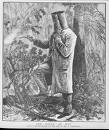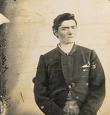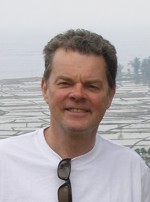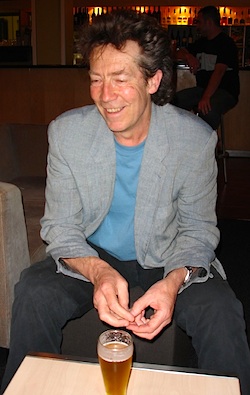
| Jacket 40 — Late 2010 | Jacket 40 Contents | Jacket Homepage | Search Jacket |
This piece is about 7 printed pages long.
It is copyright © Ken Bolton and Jacket magazine 2010. See our [»»] Copyright notice.
The Internet address of this page is http://jacketmagazine.com/40/r-forshaw-rb-bolton.shtml
Cliff Forshaw
A Ned Kelly Hymnal
reviewed by
Ken Bolton
The Paper/Cherry On Top Press, Sheffield UK, 2008
1
Jacket is an international magazine. Possibly it is ‘of’ the anglophone world. Possibly its editors’ Australian location gives that orientation a degree of antipodean inflection or colour. Is there — there is, isn’t there — a reason why an Australian should review this British writer’s book on the subject of Ned Kelly?
2
Forshaw’s brief period of residency in Australia means that the book can in part be taken as a gesture of fellow-feeling, an attempt to share in the fascination of Ned Kelly, the pull of the icon, the enigma and mystery, particularly, that the artist Sidney Nolan has given the figure, and so on.

Ned Kelly
3
An unavoidable if extraneous problem in dealing with Forshaw’s book initially is one of provenance. The Ned Kelly myth is ours, isn’t it? Should a UK poet be dealing with it? Is it a tiresome provocation, or a friendly act of sharing, of taking on some Australian lore? In fact it does seem mainly the latter. As well, our touchy proprietoriality exists because the myth never settles. It is a real story, of course, but its meanings are contested and responses to Kelly are various and often opposing.
4
Kelly the rebel representation of struggler Irish settlers is approved by the left-leaning and celebrated as antecedent exemplar of loveable and quintessential larrikinism. Those more on the side of order and property are hostile to regarding Kelly as anything other than a ‘common criminal’. Divisions between Catholic and protestant don’t much signify in Australia any more — though when they did (right up to the 1960s) Catholics tended to approve Kelly and Protestants more often disapprove; Kelly is Labor Party rather than Liberal. Kelly straddles a host of divides, of ethnicity, religion, class and political orientation. Some are old and irrelevant (who’s Catholic or Protestant anymore?), some have been swept under the carpet, or overlain with more pressing divisions.

First Class Marksman, by Sidney Nolan
5
Kelly is tiresome, too, for the degree of bad faith he stirs up. That is, Australians don’t rebel often or successfully in an organised way. We are still not a republic. For example. The right is more likely to organise — think of De Groot in the 1920s, the invention of the Liberal Party in successful reaction to the Labor Party’s existence, the population’s responsiveness at the polls to calls for order and government by our social betters: most recently Howard’s long run of electoral victories, Fraser’s ruling under the rubric of belt-tightening, the repudiation of Whitlam and Keating.
6
Secondly, Australians are not notably rebellious individually. Compared to Americans they are dutiful and respectful of authority. Invocations of ‘the Kelly spirit’ and our loveable Aussie larrikinism read always as complacent and sentimental self-congratulation, as so much bullshit designed to cement audience approval and mould assent — through reiteration if not through accuracy.
7
Ned doesn’t make any intellectual happy. For most it is like a rankling family argument that never gets resolved and so has been dropped. Here, with A Ned Kelly Hymnal, a guest raises the ghost merely to be amusing — to all of us — not realising what ambivalence, shame and irritation attach. Persecution of the Irish devolved to discrimination (no jobs in the public service, for example) that diminished, to peter out in the 1960s; the Labor Party is now much less a Catholic party or an Irish one. People (less and less) take sides when Kelly is mentioned: once they either winked and raised a glass, or sniffed and ‘said no more’. For most of my life he was a cliché without depth.
8
He was real enough. So were the divisions. His “Jerilderie Letter” is a terrific document, a pro sua vita. (For non-Australian readers who may not know: Kelly was an Irish Australian in rural Victoria, born in 1855 and hanged in 1880, after a career as a charismatic bushranger which may have begun as mere high spirits but deepened in retaliation against Anglo policing and the social divisions of the time. His escapades, and eventual use of armour and metal head-gear in a final gun battle with the police, captured the public imagination.)
9
All this is a lot for a small book of poems to face up to. You have to take the Hymnal as it is offered. Plainly, I found it hard to do that, certainly until I’d read some way in and calmed down and begun them again. What are they like? What does Forshaw do?
10
Does he deal with the ‘existential’ Ned? Yep, to a degree. There is no mention of Irish/English tensions and class warfare. There is an awareness of how shallow is our public use of the man and the myth — shallow because we can’t agree what depth to give it — Ned as endorsement of a kind of Shane Warne bluff confidence.

Ned Kelly
11
The book ends with a very strong treatment of Ned as Orpheus figure — that probably owes something to Sid Nolan’s haunting depictions. Crucially, though, the poem rises to the occasion and is not embarrassed by comparison with the paintings.
12
The first poem deals with the image of Ned Kelly that is nowadays probably the most familiar, Nolan’s. It’s in rhymed couplets and has some of the gormless bounce of bush balladry as it notes the black symbol-figure “painted out as if already dead”: “Sometimes it’s just a blank, that slit for eyes” that you look right through “to clear blue skies”.
13
Sometimes that void’s red-tinged with fire or dawn
the burbling billy-can, the day’s first yawn
14
“Sometimes he rides away (Black gun. Black horse) // into another picture … riding into myth.”
15
Punctuating the book visually are photographic details that together make up the whole of the police picture — of Kelly in chains, propped so he can plausibly stand. The original’s function, like the photos of the dead and exhumed Che Guevara, was to testify to his capture and defeat, but also, in the case of Ned’s police portrait, to register the bravado and glamour of the man. In A Ned Kelly Hymnal, as we turn the pages, we come upon first one side of the face, then the shoulder and arm, each of the chained legs, the wounded arm (disguised), lastly the other side of the handsome head.
16
You’ve seen those Sidney Nolan paintings? Gawky
uniforms riding shotgun through red or ochre.
Bush. In the gums, a bucketed head: Ned’s helmet,
that famous, awkward square of black. Wild whites,
eyes dotted, peepers trapped in its narrow slit.
17
This description (in the second poem, ‘Poster Boy’) — summarising a typical Sidney Nolan painting — goes on to focus on the wanted ad poster and its promised reward.
18
The poem following, ‘PR’, remarks on the ubiquity of the Kelly image (its nationalistic use in Australia’s self-regarding representations of itself, recommendations of itself to the rest of the world — though Forshaw is kind enough not to underline these points himself) and notes the image and the meaning turning into money, a landscape painting appreciating in value with the simple forged addition of the Kelly figure.
19
It concludes: —
20
An enigma in the painted bush
holds you, the viewer up. Under the hammer:
views to die for. Lock, stock and barrel.
A gavel shatters the panelled room’s judicious hush.
21
The whites of the two eyes, often the only thing animating the Kelly helmet’s slit (the poet here with Nolan still), are comic yet existential: “you think of a pair staring out, / framed by a cell door’s slit”. A sudden play is made here with black and white, to garner the racial equations the myth can address.
22
… eyes you saw the day the constables rode in?
The Boss unhooked that length of rawhide
from behind the stable door…
Whites. And what peeped out from deep inside
that scared blackfella’s skin.
23
After these introductory poems with their reflections on Kelly in his contemporary currency and ubiquity comes a longer poem focusing on Ned himself. This shift escapes the iconographical gravitational pull of Nolan’s paintings. It makes more reference to the known narrative — of particular days and the preparations of Kelly and gang for the big show-down that was to be their last: the detail evokes more of the story than the poem itself can tell.
24
Section three of the book’s title poem, ‘A Ned Kelly Hymnal’, follows the lines “And who will sing the ballad / of the Hotel Glenrowan?” and begins
25
Stopped at the Inn. Thin walls,
spinsters, Victorian wallpaper
pinned like a summer dress
to a mannequin.
Breastplate, Iron corset.
In the backroom,
a rifle’s barrel
rests against a spindle.
Remember, some time back,
a beard in a frock:
Steve, cross-dressed, saddling up,
spurs catching at his hem.
And now the clumsy
groin-piece has gouged
a blackgum furrow
along a lacquered table
26
And the material difficulty is captured: —
27
Ninety-seven pounds
of imperturbability.
Each movement pondered,
in all its awful gravity.
Blinkered. Stare straight ahead.
That pull of earth.
Heaviness finding sweat
beneath the long oilskin coat
28
“Nowhere to run. No need to hide,” as the poem remarks later.
29
At its end The ‘Hymnal’ describes the photo that we’ve seen quoted, via its parts (a little like a dismembering), throughout the book. —
30
A photo of Kelly
the day before he’s hanged,
shows he’s casually arranged
a paralysed left arm:
hooked the dead meat
into his belt,
while his right’s
nonchalant on his hip.
He’s hip alright.
with a cool and oily quiff,
big-bearded prophet meets
an Elvis avant la lettre.
He stares the future out
— not going to fall
on his face or to his knees.
31
The final poem considers a less usual Nolan, one in the Walker Gallery, in Liverpool, UK, Death of a Poet. Here Nolan paints — for the first? the only time? — Ned’s unhelmeted head: as that of Orpheus. It is caught in branches of a tree or scrub. The poem is effective both as evocation of the painting — Nolan’s often very thin, dry, scraped paint and the pale, high-summer, desert colours — and as a restatement of the painting’s figuring of Kelly as prophet and spokesperson and poetically fated martyr to something abstract and unattainable — freedom, justice, contentment.
32
After my conflicted and hysterical introduction, what do I make of the book? It treats the subject with sympathy, alert to the hyperbole around the myth and to the magnitude of what Kelly might have stood for ‘in reality’, or in his reality, and Forshaw sees too the poignancy of these things devolving upon an individual who is rendered both scapegoat and hero. A Ned Kelly Hymnal is least interesting and least intense and least sharp in dealing with the posthumous adventures and guises of the iconography. Most of this treatment necessarily resorts to a kind of checklist — of things that must be noted, because everybody notes them. True, they make a subject fit for discussion: the sociological and historical perspectives of the sort mooted earlier. Forshaw’s chosen mode is not discursive enough to ruminate much: its recognitions must be signalled briefly, like dot-points.
33
But it is also true that the constellation of Kelly representations serves to isolate him and to remove him from us: the man going to his death, who can never be known because so often, and so variously, invoked and described. This effect Forshaw understands and works. His Kelly escapes us, like the forever singing head of Orpheus. The lyrical ending of A Ned Kelly Hymnal is good. So, too, the title poem within the book.
34
Nolan’s Ned Kelly looms large. It has surely boosted and kept the legend alive. Forshaw uses it (as it can’t be got around) and ends by dealing directly and responsively to the Orpheus-Kelly painting: it conveys exactly the painting’s atmosphere and colouring and its import: Kelly remains an enigma, even here, without disguise (a unique instance among Nolan’s representations, Forshaw notes: for once no helmet). But Kelly’s eyes here are hidden, turned from us to the blue.
35
The early poems’ light adumbrating of the clichés and unexamined, unearned vauntings of Ned Kelly (as Aussie larrikin and champion of the knockabout roaring-boy) is almost bound to be itself a bit glib and easy. Forshaw does not entirely escape the tackiness of the material in the early part of his book. Much of the rest must, to some degree, require of the reader familiarity with the Kelly story and maybe some prior enlistment in the tensions the myth has for so long played to. Australians then.
36
The book’s aspect as a gift from a visitor is one of its charms, nervous as it made me initially. Its function as an exchange with Australia, its need to quickly re-tell a largely known story, estimate a generally known state of play, mean it is cast in an accessible, undemanding form. It means also that they seem unambitious aesthetically. The opening poems are not formally impressive, but they make enough sharp observations to keep you reading. The ‘Hymnal’ poem achieves real dignity out of its mix of filmic, modernist detail and grave statement.
37
The final poem is allowed more scope formally. It offers a sort of second take on the whole matter and stands rather as ‘Art’ in relation to the more workman-like body of the book. It does suggest further reason for searching out Forshaw’s work.

Cliff Forshaw
Cliff Forshaw left school at sixteen and worked in an abattoir before studying painting at art college. After working in Spain, Mexico, Italy, Germany, and New York, and freelance writing in London, he completed his doctorate on Renaissance Literature at Oxford. Since then he has lived in Snowdonia, and taught at Bangor, Sheffield, and now Hull University. Cliff has been Hydro-Tasmania International Writer-in-Residence at Hobart, Tasmania, Australia, and winner of the Welsh Academi John Tripp Award.

Ken Bolton, photo by Suzanne Treister
Ken Bolton runs Adelaide’s “Dark Horsey”, the bookshop of The Australian Experimental Art Foundation and runs also, intermittently, The Lee Marvin readings. His most recent collection since 2006’s At The Flash and At The Baci is A Whistled Bit Of Bop (Vagabond, 2010). Also just published is Bolton’s The Circus (Wakefield Press). A selection of his art criticism as it applies to art in Adelaide was published in 2009 by the Contemporary Art Centre of South Australia as Art Writing. Also in the offing — from Puncher and Wattmann — is Sly Mongoose. You want more? -go to http://april.edu.au/